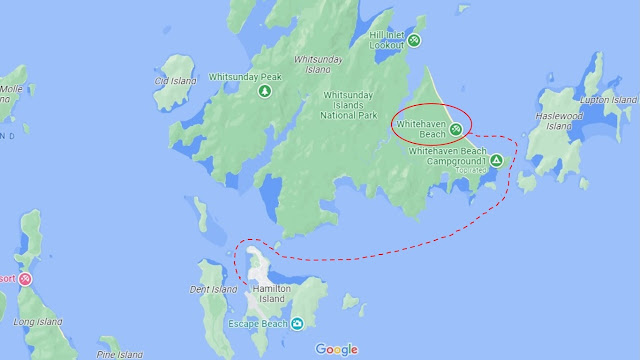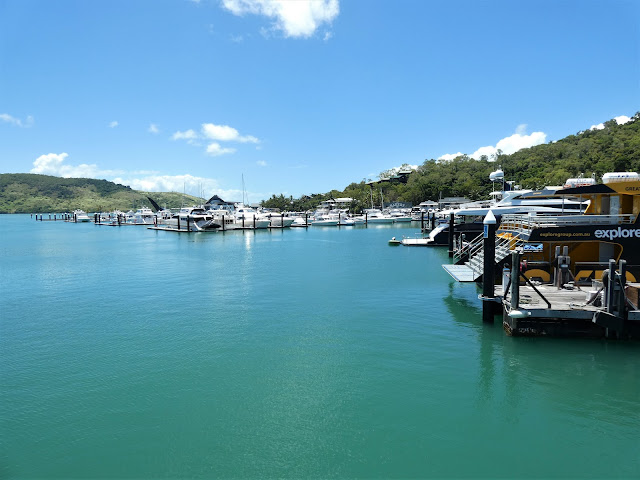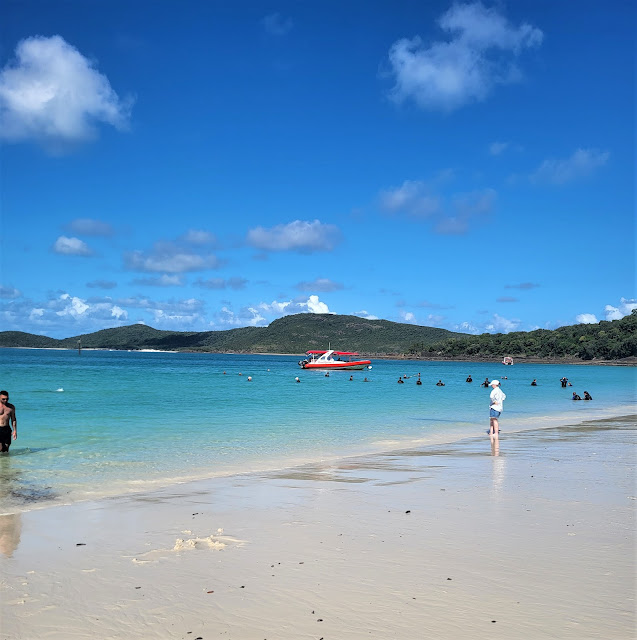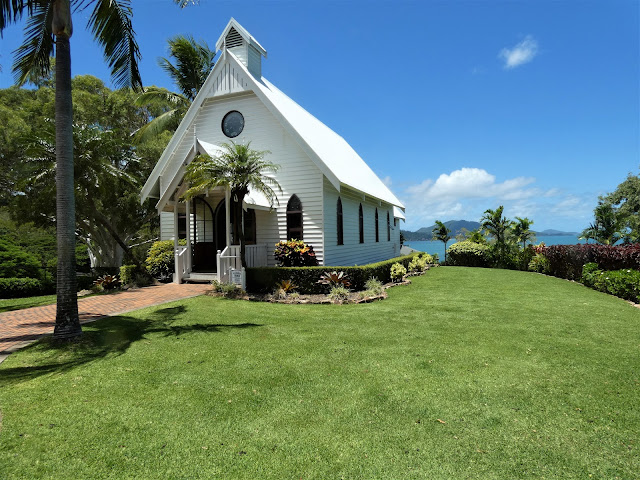After spending a glorious few days meeting up with friends and exploring the delights of Brisbane it was soon time to move on and catch a flight north to Hamilton Islands, the largest inhabited island of the Whitsunday Islands and a favourite tourist spot for visits to the Great Barrier Reef and a former home of the late George Harrison and his wife Olivia who had a compound built there in 1987 called ‘Letsbeavenue’.
 |
| JJ’s on Tour - City of Brisbane and the Queensland Maritime Museum |
The Whitsunday Islands are a group of 74 islands of various sizes 560 miles north of Brisbane off the Queensland coast and were so named after Captain Cook sailed the HMB Endeavour, through what he called the Whitsundays Passage on Sunday 3rd June 1770, providing an unimpeded passage to the north through a group of islands that formed a chain along the coast, named by Cook as the Cumberland Islands, in honour of the Duke of Cumberland, the brother of King George III.
The modern day Hamilton Island serves as a gateway to the area with its airport receiving flights from Brisbane, Sydney and Melbourne, with large resorts, camping and sailing facilities catering for several hundred thousand visitors each year.
For our few days staying on the island we based ourselves in a hotel overlooking Catseye Beach (2) after a nearly two hour flight to the nearby airport (1), whilst enjoying the restaurant facilities and the odd boat trip from the nearby marina (3) and later exploring the northern heights overlooking Hamilton Island Reef (4).
The ‘odd boat trip’ referred to saw us taking a boat to Whitehaven Beach, a very popular bathing area and exploring the Solway Circuit, a walking track that allows visitors to explore the local woodland and hills above the beach.
This few days was very much about enjoying this very beautiful part of the world, the cuisine and of course the wildlife, in and out of the water, as the change from a temperate to a more tropical climate became even more noticeable to that experienced in Brisbane.
Our hotel was a perfect location in terms of setting the agenda for the next few days with the local ‘Roos’ illustrating the tempo of life to be adopted, whilst soaking up the stunning views of sun, sea and palm trees, as well as the wonderful examples of the bird life to be seen in this part of Australia.
 |
| ‘I’m gone man, solid gone!’ |
I know some of my Aussie friends would consider the Sulphur Crested Cockatoos as a bit of a pest and we saw for ourselves the damage they could do to wooden buildings during out stay at the Carrington Hotel in the Blue Mountains, but Carolyn and I loved seeing these wonderful birds, with the occasional visit to our balcony just adding to the magic of where we were staying.
This was our first experience of really lush tropical plants and woodland since our visit to Hawaii and the hotel had signs around warning ‘newbies’ like us of the potential hazards of wondering too far off the beaten path with lurid descriptions of the horror of having a close encounter with a gympie gympie tree, Dendrocnide moroides, also referred to as the suicide plant, no doubt referring to the unfortunate folks who took the ultimate relief solution after having said close encounter.
I think I even read that the British researchers at the Biological Warfare facility at Porton Down arranged for deliveries of these nasty plants during the Cold War as part of their research into new biological weapons.
 |
| As well as the Cokatoo’s the nearby palms were festooned with these stunning Rainbow Lorikeets, Trichoglossus moloccanus, and the flash of colour moving above never failed to grab my eye. |
The marina area is the hub of the island with plenty of places to eat, a local supermarket and opportunities to organise boat trips, and we spent every evening during our stay enjoying the outdoor night life that characterises part of holidaying in Hamilton Island.
So we managed to book one of the many hire golf carts that are the principle private transport in the island and given the queues of expectant and often disappointed visitors trying to get one at short notice are well worth booking ahead to avoid disappointment.
 |
| Lancaster PG-D of 619 Squadron with her crew pictured. This might be another aircraft with the same squadron code and unfortunately the serial number is not visible |
On the night of the attack Pilot Officer, not Flying Officer as shown, MacDonald was flying Lancaster PG-D serial number JB123 and the aircraft was one of 27 other Lancasters lost that night, with aircrew losses of 168 killed and 31 made prisoner of war and with the Bomber Command War Diary recording the majority of losses in and around Berlin once the 150 to 200 nightfighters, originally directed towards Hannover and Bremen, caught up with the bomber stream.
 |
| Map from ‘The Berlin Raids’ - Martin Middlebrook |
Bomber crews that took part expressed their dismay at seeing the route planned above, with a straight in and straight out course, with a slight dog-leg after Berlin to allow the bombers to take advantage of a strong following wind from that direction, but a route that was being used for the eighth time in the previous ten raids, with no diversionary raids and despite the evidence that the bomber stream was being engaged more often using this route to Berlin.
The grief of his parents can only be imagined and, as the father of two sons and spared the horrors of modern war, I spent a few moments in grateful meditation whilst appreciating this paradisiacal location.
As an island paradise, Hamilton Island ticks a lot of the boxes, and with my bird spotting predilection, that enjoyment was only enhanced.
 |
| We first caught sight of this quintessential Australian bird, the Kookaburra in Sydney, this being the laughing variety, Dacelo novaeguineae. |
 |
| The Pheasant Coucal, Centropus phasianinus. I’ve never seen anything quite like this crossing the road at home! |
 |
| Rainbow Lorikeet, Trichoglossus moloccanus |
 |
| Torresian Crow, Corvus orru |
 |
| Pied Currawong, Strepera graculina, so named for its distinctive rollicking call, ‘curra-wong curra-wong’ |
One abiding memory of our stay in Hamilton Island were the evening sunsets, and we both enjoyed just sitting and watching the horizon change colour as the sun slowly lowered in the evening sky.
So the adventure continues in the next post as we fly further up the coast to Port Douglas and get to explore the Daintree Rainforest before moving on to Palm Cove, yet another beach side paradise in northern Queensland.
Next up: I’m off to Clotted Lard this weekend to play the Bantry Bay Scenario, plus I have an adventure on Dartmoor to report and a new fleet build project has started with the first models nearing completion.
More anon
JJ





































































Another nice roundup JJ. I have only been to Hamilton Island twice but have enjoyed it thoroughly. The second time was on the work dollar, which is definitely the way to do it.
ReplyDeleteHi Lawrence,
DeleteThanks for your comment, and yes I'm sure the second option for visiting was much better. Like you we found the islands delightful and would encourage others to visit should the opportunity present.
JJ
I do enjoy these posts, particularly the birds. They make for pleasant Sundays. Thanks for all the hard work in posting them.
ReplyDeleteHi and thank you.
DeleteAs I frequently comment, it's really great to be able to share these experiences with others, and comments like yours are very welcome, making the effort no effort at all, in the anticipation that they might brighten someone else's day, and I enjoy occasionally going back over old posts and reminding myself of good times.
Cheers
JJ